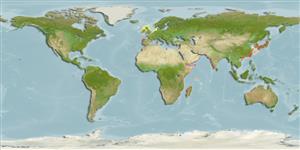Polychaeta |
Not assigned |
Sabellariidae
Environment: milieu / climate zone / تغييرات عمق / distribution range
بوم شناسي
. Subtropical
Indo-West Pacific and Northeast Atlantic.
Length at first maturity / Size / Weight / سن
بلوغ: Lm ? range ? - ? cm
Occurs from lower intertidal or sublittoral fringes to subtidal (Ref. 107820).
Life cycle and mating behavior
بلوغ | تولید مثل | تخم ریزی | Eggs | Fecundity | Larvae
Members of the class Polychaeta are mostly gonochoric (sexual). Mating: Females produce a pheromone attracting and signalling the males to shed sperm which in turn stimulates females to shed eggs, this behavior is known as swarming. Gametes are spawned through the metanephridia or body wall rupturing (termed as "epitoky", wherein a pelagic, reproductive individual, "epitoke", is formed from a benthic, nonreproductive individual, "atoke"). After fertilization, most eggs become planktonic; although some are retained in the worm tubes or burrowed in jelly masses attached to the tubes (egg brooders). Life Cycle: Eggs develop into trocophore larva, which later metamorph into juvenile stage (body lengthened), and later develop into adults.
مآخذ اصلی
مراجع | هماهنگ كننده | همكاران
Wehe, T. and D. Fiege 2002 Annotated checklist of the polychaete species of the seas surrounding the Arabian Peninsula: Red Sea, Gulf of Aden, Arabian Sea, Gulf of Oman, Arabian Gulf. Fauna of Arabia 19:7-238. (مرجع 2663)
وضعيت در فهرست قرمز IUCN
(مرجع 130435: Version 2025-1)
وضعيت از نظر سايتس (مرجع 108899)
Not Evaluated
Not Evaluated
خطر برای انسان ها
Harmless
استفاده انسانی
| FishSource |
ابزارها
اطلاعات بيشتر
Population dynamicsرشدMax. ages / sizesLength-weight rel.Length-length rel.نوسانات طولیMass conversionفراواني Life cycleتولید مثلبلوغFecundityتخم ریزیEggsنمو تخمLarvae PhysiologyOxygen consumption
Human RelatedStamps, coins, misc.
منابع اينترنتي
Estimates based on models
